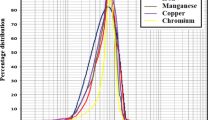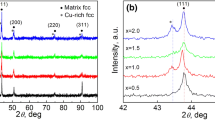Powder metallurgy methods were used in this study to prepare the CrCuFeNiMo0.3 high-entropy alloy. The alloy’s microstructure, hardness, compression, and corrosion resistance were examined by means of field emission scanning electron microscopy (FESEM), energy-dispersive spectroscopy (EDS), and X-ray diffraction analysis (XRD), as well as employing micro Vickers hardness tester, materials testing machine, and electrochemical workstation. The experimental results revealed light- and dark-colored areas in the alloy's microstructure. The edge of light color was petal-like. Also, alternating stripes were observed in the light-colored area of the microstructure. The EDS and the element surface distribution analysis of the CrCuFeNiMo0.3 alloy revealed the tendency of the elements to segregate. The distribution of chromium, iron and nickel elements is more uniform, while copper elements were enriched in intergranular position, with molybdenum tending to segregation the most. The reason is that the melting point of molybdenum is the highest in the studied CrCuFeNiMo0.3 high-entropy alloy. During sintering, the internal and edge parts of the pressed cylindrical samples were unevenly heated on the micro-level, leading to the irregular diffusion of atoms and facilitating segregation. The segregation of copper elements largely relates to the mixing enthalpy between elements. The mixing enthalpy of the studied CrCuFeNiMo0.3 high-entropy alloy with five principal components is larger than that of intermetallic compounds. It forms simple FCC and BCC structures, inhibiting the emergence of brittle intermetallic compounds. Solution strengthening effect and grain refining effect of molybdenum increase the alloy’s hardness and strength. The highest microhardness value of the alloy was 766 HV, and the compressive strength amounted to approximately 1782 MPa. The fracture mechanism is a quasi-cleavage fracture. The corrosion current density of the alloy in 3.5% NaCl solution is 5.35 ⋅ 10–6 mA/cm2, and the corrosion potential is –0.52 V. Also, the corrosion of the alloy surface is slight, without pitting, and is mainly concentrated in the grain boundary and some light-colored structures.









Similar content being viewed by others
References
Z.M. Li, K.G. Pradeep, Y. Deng, D. Raabe, and C.C. Tasan, “Metastable high-entropy dual-phase alloys overcome the strength–ductility trade-off,” Nature, 534, 227–230 (2016).
K. Masemola, P. Popoola, and N. Malatji, “The effect of annealing temperature on the microstructure, mechanical and electrochemical properties of arc-melted AlCrFeMnNi equi-atomic High entropy alloy,” J. Mater. Res. Technol., 9, No. 3, 5241–5251 (2020).
H. Torres, S. Slawik, C. Gachot, B. Prakash, and M.R. Ripollm, “Microstructural design of self-lubricating laser claddings for use in high temperature sliding applications,” Surf. Coat. Tech., 337, 24–34 (2018).
Y. Zhang, Z. Chen, D.D. Cao, J.Y. Zhang, P. Zhang, Q. Tao, and X.Q. Yang, “Concurrence of spinodal decomposition and nano-phase precipitation in a multicomponent AlCoCrCuFeNi high-entropy alloy,” J. Mater. Res. Technol., 8, No. 1, 726–736 (2019).
X.R. Feng, X.F. Cui, G. Jin, W. Zheng, Z.B. Cai, X. Wen, B.W. Lu, and J.M. Liu, “Underwater laser cladding in full wet surroundings for fabrication of nickel aluminum bronze coatings,” Surf. Coat. Tech., 333, 104–114 (2018).
S.J. Sun, Y.Z. Tian, H.R. Lin, X.G. Dong, and Z.F. Zhang, “Enhanced strength and ductility of bulk CoCrFeMnNi high entropy alloy having fully recrystallized ultrafine-grained structure,” Mater. Design. 133, 122–127 (2017).
M. Song, R. Zhou, J. Gu, Z.W. Wang, S. Ni, and Y. Liu, “Nitrogen induced heterogeneous structures overcome strength-ductility trade-off in an additively manufactured high-entropy alloy,” Appl. Mater. Today., 18, 100498 (2020).
S.S. Nene, S. Sinha, M. Frank, K. Liu, R.S. Mishra, B.A. McWilliams, and K.C. Cho, “Unexpected strength–ductility response in an annealed, metastable, high-entropy alloy,” App.l Mater. Today, 13, 198–206 (2018).
G.A. Salishchev, M.A. Tikhonovsky, D.G. Shaysultanov, N.D. Stepanov, A.V. Kuznetsov, I.V. Kolodiy, A.S. Tortika, and O.N. Senkov, “Effect of Mn and V on structure and mechanical properties of high-entropy alloys based on CoCrFeNi system,” J. Alloys Compd., 591, 11–21 (2014).
L. Liu, J.B. Zhu, C. Zhang, J.C. Li, and Q. Jiang, “Microstructure and the properties of FeCoCuNiSnx high entropy alloys,” Mat. Sci. Eng. A, 548, 64–68 (2012).
D.B. Miracle and O.N. Senkov, “A critical review of high-entropy alloys and related concepts,” Acta Mater., 122, 488–511 (2016).
Y.Z. Lu, G.K. Huang, Y.Z. Wang, H.G. Li, Z.X. Qin, and X. Lu, “Crack-free Fe-based amorphous coating synthesized by laser cladding,” Mater. Lett., 210, 46–50 (2018).
D. Choudhuri, i B. Gwalan, S. Gorsse, C.V. Mikler, R.V. Ramanujan, M.A. Gibson, and R. Banerjee, “Change in the primary solidification phase from fcc to bcc based B2 in high entropy or complex concentrated alloys,” Scripta Mater., 127, 186–190 (2017).
B. Gludovatz, A. Hohenwarter, D. Catoor, E.H. Chang, E.P. George, and R.O. Ritchie, “A fracture-resistant high-entropy alloy for cryogenic applications,” Science, 345, 1153–1158 (2014).
Y.P. Lu, H. Jiang, S. Guo, T.M. Wang, Z.Q. Cao, T.J. Li, “A new strategy to design eutectic high-entropy alloys using mixing enthalpy,” Intermetallics, 91,124–128 (2017).
N.D. Stepanov, D.G. Shaysultanov, R.S. Chernichenko, D.M. Ikornikov, S.V. Zherebtsov, “Mechanical properties of a new high entropy alloy with a duplex ultra-fine grained structure,” Mat. Sci. Eng. A, 728, 54–62 (2018).
S.K. Wong, T.T. Shun, C.H. Chang, and C.F. Lee, “Microstructures and properties of Al0.3CoCrFeNiMnx high-entropy alloys,” Mater. Chem. Phys., 210, 146–151 (2018).
T. Park and J.H. Kim, “Tensile properties and microstructure evolution during two-stage tensile testing of CoCrFeMnNi high-entropy alloy,” J Mater. Res. Technol., 9, No. 4, 7551–7557 (2020).
Y.Z. Shi, B. Yang, X. Xie, J. Brechtl, K.A. Dahmen, and P.K. Liaw, “Corrosion of AlxCoCrFeNi high-entropy alloys: Al-content and potential scan-rate dependent pitting behavior,” Corros. Sci., 119, 33–45 (2017).
B. Wu, Z.Y. Xie, J.C. Huang, J.W. Lin, Y.X. Yang, L.Q. Jiang, J.L. Huang, G.X. Ye, C.F. Zhao, S.J. Yang, and B.S. Sa, “Microstructures and thermodynamic properties of high-entropy alloys CoCrCuFeNi,” Intermetallics, 93, 40–46 (2018).
Q.Q. Ding, Y. Zhang, X. Chen, X.Q. Fu, D.K. Chen, S.J. Chen, L. Gu, F. Wei, H.B. Bei, Y.F. Gao, M.R. Wen, J.X. Li, Z. Zhang, T. Zhu, R.O. Ritchie, and Q. Yu, “Tuning element distribution, structure and properties by composition in high-entropy alloys,” Nature, 574, 223–227 (2019)..
Y.G. Yao, Z.N. Huang, P.F. Xie, S.D. Lacey, R.J. Jacob, H. Xie, F.J. Chen, A.M. Nie, T.C. Pu, M. Rehwoldt, D.W. Yu, M.R. Zachariah, C. Wang, R. Shahbazian-Yassar, J. Li, and L.B. Hu, “Carbothermal shock synthesis of high-entropy-alloy nanoparticles,” Science, 359, 1489–1494 (2018).
Zh.F. Lei, X.J. Liu, Y. Wu, H. Wang, S.H. Jiang, S.D. Wang, X.D. Hui, Y.D. Wu, B. Gault , P. Kontis, D. Raabe, L. Gu, Q.H. Zhang, H.W. Chen, H.T. Wang, J.B. Liu, K. An, Q.S. Zeng, T.G. Nieh, and Z.P. Lu, “Enhanced strength and ductility in a high-entropy alloy via ordered oxygen complexes,” Nature, 563, 546–550 (2018).
P. Wang, P.F. Huang, F.L. Ng, W.J. Sin, S.L. Lu, M.L.S. Nai, Z.L. Dong, and J. Wei, “Additively manufactured CoCrFeNiMn high-entropy alloy via pre-alloyed powder,” Mater Design., 168, 107576 (2019). https://doi.org/10.1016/j.matdes.2018.107576.
Y.Q. Jiang, J. Li, Y.F. Juan, Z.J. Lu, and W.L. Jia, “Evolution in microstructure and corrosion behavior of AlCoCrxFeNi high-entropy alloy coatings fabricated by laser cladding,” J. Alloys Compd., 775. 1–14 (2019).
X.W Qiu, “Microstructure and mechanical properties of CoCrFeNiMo high-entropy alloy coatings,” J. Mater. Res. Technol., 9, No. 3, 5127–5133 (2020).
X.W. Qiu, “Corrosion behavior of Al2CrFeCoxCuNiTi high-entropy alloy coating in alkaline solution and salt solution,” Results Phys., 12, 1737–1741 (2019).
J.B. Cheng, D. Liu, X.B. Liang, and B.S. Xu, “Microstructure and electrochemical properties of CoCrCuFeNiNb high-entropy alloys coatings,” Acta Metall. Sin., 27, No. 6, 1031–1037 (2014).
X.W. Qiu, M.J. Wu, Y.J. Qi, C.G. Liu, Y.P. Zhang, and C.X. Huang, “Microstructure and corrosion resistance of Al2CrFeCoCuNixTi high entropy alloy coatings prepared by laser cladding,” Infrared Laser Eng., 47, No. 7, 0706008 (2018).
X.W. Qiu, Y.P. Zhang, L. He, and C.G. Liu, “Microstructure and corrosion resistance of AlCrFeCuCo high-entropy alloy,” J. Alloys Compd., 549. 195–199 (2013).
Acknowledgments
This work was supported by the Key R & D Projects of Deyang Science and Technology Plan, Sichuan Province, China (No. 2021SZ009), and the Sichuan College of Architecture Technology Project.
Author information
Authors and Affiliations
Corresponding author
Additional information
Published in Poroshkova Metallurgiya, Vol. 60, Nos. 11–12 (542), pp. 14–24, 2021.
Rights and permissions
About this article
Cite this article
Qiu, X. Structure, Mechanical Properties, and Corrosion Resistance of the CrCuFeNiMo0.3 High-Entropy Alloy Prepared by Powder Metallurgy. Powder Metall Met Ceram 60, 662–671 (2022). https://doi.org/10.1007/s11106-022-00278-w
Received:
Published:
Issue Date:
DOI: https://doi.org/10.1007/s11106-022-00278-w




